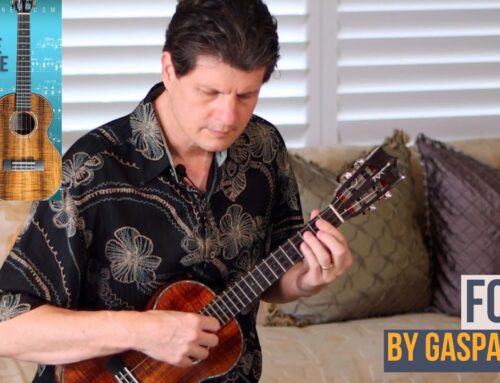Nails or No Nails on Ukulele?
Should you use nails or no nails when playing fingerstyle ukulele? Using fingernails in the right (strumming and picking) hand can add volume and a range of tones to your ukulele playing. They can also break, can get rough and uneven producing a weak, shrill sound, and can catch on the strings accidentally if not shaped properly. Not cool!
Starting out without nails
With this in mind, I would highly recommend not using nails when you fist start learning the ukulele. We will always keep the left (fretting) hand nails short so that they don’t get in the way as you keep your fingers curved when making contact with the strings and fingerboard. Starting out without nails will produce a warm tone and will allow you to focus on the motion of the fingers as you develop coordination, control, and relaxation in the right hand. Many great ukulele artists continue using this technique without nails. Some use a plastic thumb pick that adds volume when strumming and picking individual notes. The thumb pick requires changing your thumb position to a place higher off the strings so the pick has enough clearance.
“The point of contact”
When playing with an extended index finger in the traditional style of ukulele playing, you make contact with the string on the pad of the finger away from the nail. You will use this point of contact even when you grow out your nails to produce a warm sound. The nails don’t make contact from this position.
When you play with the curved “C” shape in a classical position, you want to make contact on the tip of the finger. Before trying this, make sure the nails are cut as short as possible (don’t cut them too short and hurt your fingers!). When the nails are nice and short, try placing fingers on various strings aiming for the left side of the finger at the point where the nail would start if grown out.
The right hand in this position plays at around a 45-degree angle so this point of contact should happen naturally as you approach the string with index, middle, and ring fingers. The thumb should make a similar point of contact on the left edge and should curve back slightly instead of curving the tip joint in (remember “banana thumb”).
Finger placement
Practice this finger placement very slowly by touching the four strings with these four fingers: Thumb touching the 4th string, index touch the 3rd string, middle touching the 2nd string, and ring touching the 1st string. Don’t play the strings at first. Just place your fingers in position. Now put a little pressure into the string. Let the weight of gravity help. You should see the strings dip down slightly. Now release the strings as a four-note chord by moving you thumb into a relaxed fist. Try this as a four note chord then individually and in groups of two and three fingers. Always try to make the same point of contact. Think of three stages of playing each note or chord:
- Contact (on the left side)
- Pressure (see the strings dip slightly)
- Release (into a relaxed fist)
You can experiment with this point of contact and three-step process of playing each note across different strings or by repeating index/middle, index/ring, middle/ring, and thumb/index on the same string. We will explore many combinations of fingerings but the finger placement will usually be exactly the same—playing off that left side of the finger where the nails begin.
Transitioning to nails
Eventually after getting comfortable with this placement and playing a range of music without nails, you can try growing your fingernails to get a louder sound and more tonal range. I suggest filing each nails at a 45-degree angle from the left side of each finger as far across the nail as possible creating a ramp from left to right. We will use the same point of contact on the left side of the finger where the nail begins. If you don’t file the nail, it will form a hook that catches on the string and will sound thin.
I use a file, then very fine grade sandpaper (Tri-Mite sandpaper from stringsbymail.com) to smooth out all the roughness. You can usually find a similar 2000-plus grit sandpaper at hardware stores. Tell the staff at one of these stores your are shopping for sandpaper for your nails to play ukulele and see if they call security! Anyway, using sandpaper after filing makes a HUGE difference in tone. It also creates less resistance as the nails move across the strings. The flesh of the fingertip is still used in combination with the nail. This balance of warmth and volume produces an ideal sound. For an added benefit, tilting the hand to the right creates a brighter sound when needed like turning the treble up on a stereo system. This change in tone happens because you are now using more nail than fingertip, which brightens the sound.
***
Have fun experimenting with finger placement and tone production without nails at first. Take your time and enjoy the beautiful sound that results.
***
While you’re here, check out some of our other free lessons here!
If you would like to purchase one of our 4 books, please go here.
If you would like to dive much deeper into learning fingerstyle ukulele with a structured guide for your progress, join Ukulele Corner Academy, our online school for fingerstyle ukulele.



[…] are cut short to give your fingers a clean hold on the string. On the contrary, you should grow the nail on your strumming finger a little bit to give it a smoother glide across the […]
I used my fingernails on a beautiful ukulele and I scratched of the finish, even causing a gouge on the ukulele top. If you use nails, cover the sund board with plastic film cut to create a pick guard. The Strings by Mail site sells the static cling plastic sheets.
That’s a great tip, Ann! Thanks for sharing. Yes, you do have to be careful not to scratch the top so the film will come in quite handy.
Peace,
Dave B (UC team)
Jeff…could you add to your comments on nail shaping with a little video showing what you do and the “finished product.”
Hi Larry, That is a great idea. I’ll work on that.
I have serious arthritis in my left index finger. It hurts a lot to press the flesh on the strings. Is it possible to press with a slightly longer nail instead of flesh?
Hi Elaine,
I’m sorry to hear you are experiencing pain in your hands. It is hard to control your sound and get a good tone using nails on your fretting hand. Nails are more commonly used in the picking (right) hand.
I use acrylic glue on nails for two reasons. My nails break and it often impossible to have the right shape nail. And consistency of the contact surface and nail top. Unfortunately, glue on nails do fall off so they have to be reapplied fairly regularly.
Hi Alex,
Acrylic nails work really well and they usually sound pretty great too. A nice solution for breaking nails.
Peace,
Dave B (UC team)
Thank you!
You’re most welcome, Shannon! Glad you enjoyed the article.
Peace,
Dave B (UC team)
My personal preference: I prefer the warm sound of no nails. I even make picks from wine corks to get the same sound as my thumb but the volume, speed, and attack of a pick. Of course if I was better with my nails or finger picks that might change my attitude,
Hi George,
No nails do produce a nice sound and if it works for you, go for it!
Peace,
Dave B (UC team)
It depends on what I am playing as to whether I use nails or not. I have to experiment to hear what sounds best to me. I’m not the best yet, but still learning and trying to get a really good tone. Thanks for this lesson!
I’m finding it impossible to press the strings down with my fingertips because my nail bed is in the same position as my fingertips. ie even if I file my nails as short as possible, even to the point of slightly hurting as I file, my nails still stick out further than my fingertips!
So when I try to fret chords I am always touching other strings because of the angle I need to put my fingers into in order to press the string with my fingertip, as opposed to my nail. So all my chords sound dull and slightly wrong!
What can I do to be able to actually press strings without inadvertently touching other strings?
Aloha Alina, I am sorry to hear you have this issue with your fingernails. If you have files the nails down as much as possible and still have issues with the nails still extending beyond the fingertip you might try to work on your wrist position, thumb placement, and finger curvature. Also make sure that the neck of the ukulele is raised to about a 45 degree angle so you can have a good left hand set up.
Mahalo,
Jeff